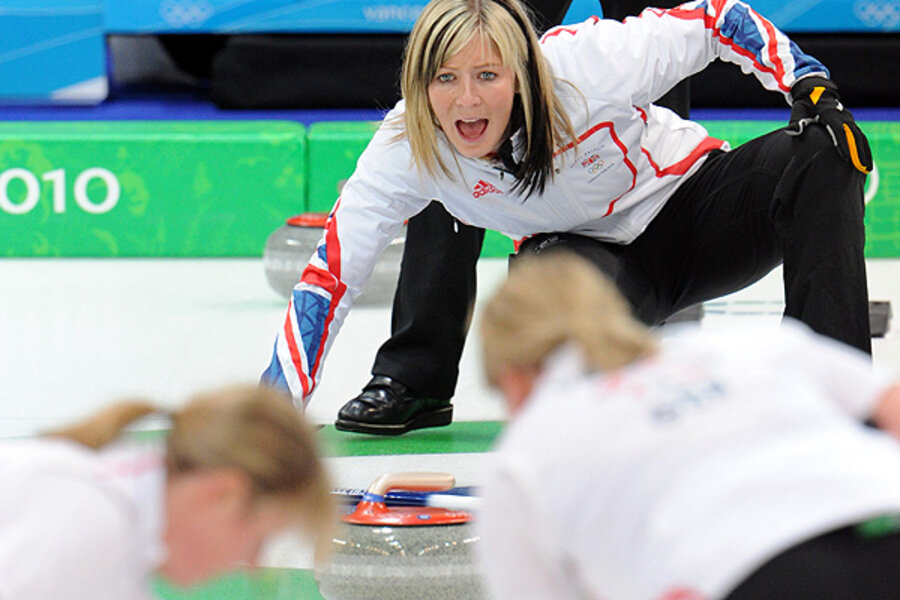From curling, with love: scoring explained in seven easy steps
Loading...
| Vancouver, British Columbia
The women of the United States curling team scored a big 6-5 upset over Great Britain Saturday, when the American skip made a great draw to the button in the extra end and British skip’s shot with the hammer flew wide of the center of the house.
Now, if America only had any idea what that meant.
By the unimpeachable gauge of google.com, quite a few people are seeking an understanding of “curling game scoring” or some permutation thereof.
Never fear. As your omniscient guide to the sometimes-impenetrable world of the Winter Olympics, I am here to tell you that the basics of curling are, in fact, not so complicated.
1. The language
The key to Curling 101 is the acceptance that you need to learn a new language without Rosetta Stone CDs. Like another sporting mystery to Americans – cricket – curling revels in its obscurity. Understanding the terminology is like a secret handshake, and only the initiated are allowed into the club.
Curling, you see, could simply call the "house" the target and the "button" the bulls-eye, but what fun would that be?
2. The scoring
The scoring, though, really is simple: You want to come closer to a bulls-eye than your opponent when all the stones are thrown.
In curling terms: The team with the stone closest to the center of the button when the end is finished gets a point. If a team has two stones closer to the center of the button than its opponent, it gets two points, and so on.
It is impossible for both teams to score in an end, since points are awarded exclusively on the basis of which team did better in the end.
The best possible score in an end is 8-0, meaning one team got all eight stones closer to the button than its opponent. This is a “snowman” or curling’s equivalent of a perfect game.
3. The rules
Thinking about curling scoring in baseball terms is actually helpful.
Baseball: nine innings. Curling: 10 ends.
Baseball: Each team gets three outs per inning. Curling: Each team gets eight stones per end.
Baseball: The home team hits last. Curling: The team that delivers last in each end is said to have the hammer.
But one "home" team does not have the hammer the entire match. It switches to whichever team did not score in the previous end. If no one scores in an end (no stones end up in the house), that's a "blank end," and the hammer remains with the same team.
4. The game
Armed with these facts, the mist around curling begins disperse.
It stands to reason that the team with the hammer – the last delivery – has an advantage. Like holding serve in tennis, teams with the hammer are expected to win the end.
If the team without the hammer wins the end, it’s called a steal.
And this was the genius of the American women’s victory Saturday. It broke Britain’s serve – or stole points – in the last two ends.
But how did it win?
Let’s deconstruct the play-by-play of the decisive deliveries of the match.
At the end of 10 ends, the score was tied, 5-5. As in baseball, the result is sudden-death extra ends: The first team to win an end wins the match.
5. 'Curling' a stone
In the extra end, the US delivered its last stone onto the button – a bulls-eye. It did this by “drawing” the stone around other stones already in play. This is where the word “curling” comes in.
A curling sheet is not smooth like speedskating ice. It is rough. This means the stone has some traction on the ice, so when it spins, it slowly “curls” up the ice. As in golf, a “draw” is simply one way of making the stone curl around obstacles to get it to where you want it to go.
6. Sweeping
The sweeping is a part of this, too.
If you want a stone to keep moving fast and straight after it is thrown, you scrub the ice in front of it with brooms. The heat of the friction melts the ice fractionally, which means the stone rides on a film of water, grabbing the ice less.
If you want a stone to curl more, you don’t sweep, allowing it to grab the rough ice.
7. How the US won
Now, back to the match.
Britain, with the hammer in the extra end, had a clear play with its final stone: knock the American stone out of the button in a way that would leave a British stone closest, winning the extra end – and the match.
But the British “skip” – the quarterback who makes the team’s strategic decisions, and who always makes the final, crucial delivery of each end – made a bad throw.
Her delivery missed the American stone and sailed past the button.
So, once again:
The United States beat Britain when the American skip made a great draw to the button in the extra end, and British skip’s shot with the hammer flew wide of the center of the house.
Let the celebrations begin!
-----
Follow Mark's Olympic Twitter feed.





